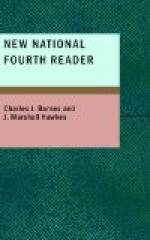The flesh of the rhinoceros is good to eat; and its strong, thick skin is made by the natives, into shields, whips, and other articles.
Though clumsy and apparently very stupid, the rhinoceros is a very active animal when attacked or otherwise alarmed, dashing about with wonderful rapidity.
It is very fierce and savage—so much so that the natives dread it more than they do the lion. In hunting the animal, it is dangerous for a man to fire at one unless he is mounted upon a swift horse, and can easily reach some place of safety.
When attacking an enemy, the rhinoceros lowers its head and rushes forward like an angry goat. Though it may not see the object of its attack, the sense of smell is so acute that it knows about when the enemy is reached.
Then begins a furious tossing of the head, and if the powerful horn strikes the foe, a terrible wound is the result.
When wounded itself, the rhinoceros loses all sense of fear, and charges again and again with such desperate fury that the enemy is almost always overcome.
A famous traveler in South Africa relates the following incident that happened during one of his hunting excursions:
“Having proceeded about two miles, I came upon a black rhinoceros, feeding on some Wait-a-bit thorns within fifty yards of me.
“I fired from the saddle, and sent a bullet in behind his shoulder, when he rushed forward, blowing like a grampus, and then stood looking about him.
“Presently he started off, and I followed. I expected that he would come to bay, but it seems a rhinoceros never does that—a fact I did not know at that time.
“Suddenly he fell flat upon the ground; but soon recovering his feet, he resumed his course as if nothing had happened.
“I spurred on my horse, dashed ahead, and rode right in his path. Upon this, the hideous monster charged me in the most resolute manner, blowing loudly through his nostrils.
“Although I quickly turned about, he followed me at such a furious pace for several hundred yards, with his horrid horny snout within a few yards of my horse’s tail, that I thought my destruction was certain.
“The animal, however, suddenly turned and ran in another direction. I had now become so excited with the incident, that I determined to give him one more shot any way.
“Nerving my horse again, I made another dash, after the rhinoceros, and coming up pretty close to him, I again fired, though with little effect, the ball striking some thick portion of his skin and doing no harm.
“Feeling that I did not care to run the chance of the huge brute again charging me, and believing that my rifle-ball was not powerful enough to kill him, I determined to give up the pursuit, and accordingly let him run off while I returned to the camp.”
[Illustration]
* * * * *
Directions for Reading.—Let pupils mark inflections in the first sentence of the lesson.




